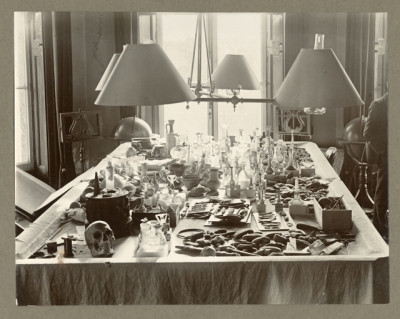To search the RPR site click here
Hilda Petrie's trip to Rushmore in 1898
The following extract from an account of a visit of Hilda Petrie's to Rushmore in 1898 is taken from MARGARET DROWER 'A visit to General Pitt-Rivers' ANTIQUITY 68 (1994): 627-30.
William Flinders Petrie and his wife Hilda stayed in Salisbury after attending a British Association for the Advancement of Science meeting in Bristol in September 1898. They took advantage of the proximity to Pitt-Rivers to call upon him on 17 September. The following account of the visit is taken from a letter to her sister from Hilda transcribed in the article.
'... Before long, we came on to Pitt-Rivers' ground, all the gates bright blue with yellow tops, like the covers of his archaeological pamphlets. I thought them ugly, but when we were driving back, they seemed nice, when one had spent all day in their fairyland, and seen the King of the place with all his magic things about him.
The General then came down, a very fine big old man, ... and then we looked over heaps of antika and curiosities in each of the rooms until lunch.
... [At lunch] There were silver plates, and 3 menservants to wait, yet it seemed a delightfully unconventional and casual household. We drove off to the museums directly afterwards and spent our aft. there with the Genl.
We drove with the Genl. through miles of park avenues ... And first we saw a fine old hunting-lodge of King John's, which Pitt-Rivers has furnished mediaevally, and fitted in part as a sort of museum, with collections of pictures of every age and style, beginning with [Egyptian] and going on to Greek and mediaeval up to modern art. ... We drove on to the private park, or pleasure ground ... altogether everything is extraordinarily laid out for amusement of the public, as well as for training them in archaeology. The museum is a large building, some miles further on, built on the site of a gipsy school, beautifully and simply built, splendidly lighted and arranged, with nothing to distract the attention, and all white-painted.
There we went quickly thro' room after room, porcelain of different countries, wood-carving, national costumes, enamels, peasant utensils etc., heathen gods and weapons, and savagery of all sorts, and a quantity of Benin copper casts were the principal things we saw, and a series of Scottish crosses ... Also sheets of comparative drawings by children, by Dorset labourers, by unlearned-in-art but educated adults, also copies of the same picture one from another, each diverging more from the original. [5]
... We drove back a different way ... and had tea with the Genl. before driving over the downs and down to Tisbury [station] again ...'
Notes (added by the transcriber for the Rethinking Pitt-Rivers project):
[1] This may be found in the early pages of volume 9.
[2] Probably Add.9455vol6_p1789 /1 and Add.9455vol6_p1789 /2, 2 Maori heads made from gum bought from Webster and Stevens Auction Rooms in 1898.
[3] Possibly a reference to the Benin bronzes, though these are mentioned later by Petrie as already being at Farnham Museum.
[4] There appears to be no reference to this in the catalogue of the second collection held at Cambridge University Library or in the documentation that the Pitt Rivers Museum holds about possible items from the founding collection which have not yet been accessioned (and sometimes refer to items Pitt-Rivers did not include in the founding collection).
[5] Balfour too played both these games at the Pitt Rivers Museum in Oxford. Beatrice Blackwood made a large collection of comparative drawings in the 1930s and 1940s during her own fieldwork. See here for more information.
Transcribed by AP, 2010. My thanks to Alice Stevenson for telling me about the Antiquity artlcle.




